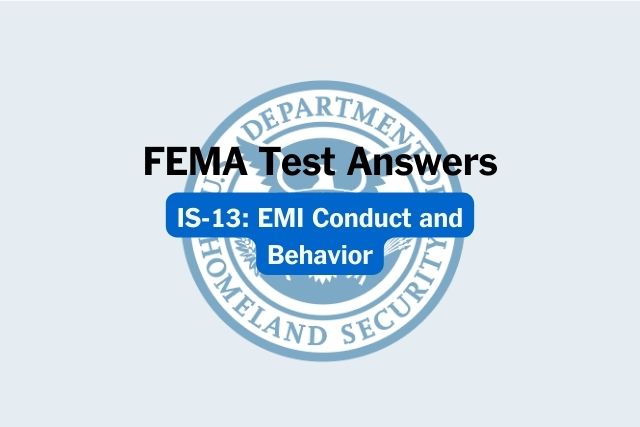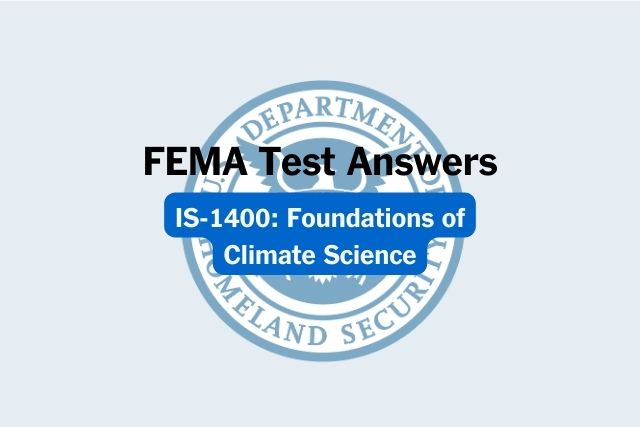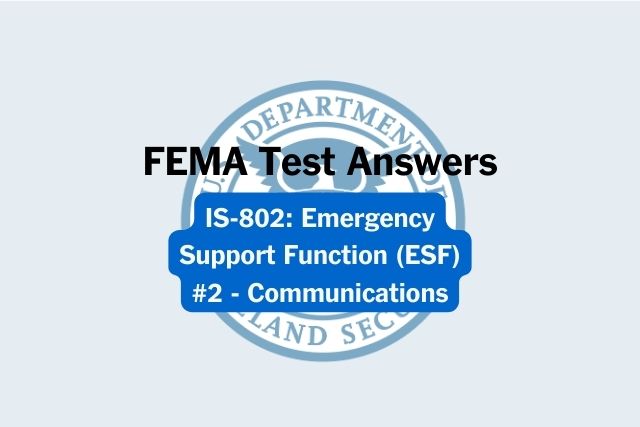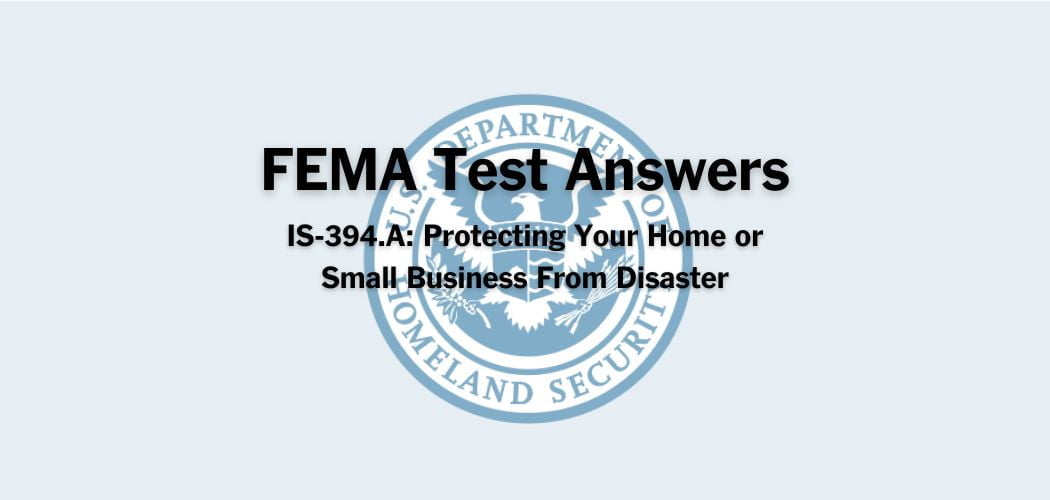Overview: The FEMA IS-2101 course was published on 12/28/2017 to provide a broad overview of the CTP Program, including its mission, activities, funding processes, and available tools and resources. Students should gain an understanding of how the program operates and how they can be successful FEMA partners.
Primary audience: IS-2101 is for CTP Program stakeholders, especially current and potential partners
FEMA IS-2101 test answers
Each time this test is loaded, you will receive a unique set of questions and answers. The test questions are scrambled to protect the integrity of the exam.
Question 1. The Blue Book’s outline the unit cost approach FEMA uses to estimate the value of partner contribution for leverage and in-kind services.
A. TRUE
B. FALSE✅
Question 2. This CTP activity includes an appeal period, a letter of final determination, a compliance period where regulatory products are adopted by ordinance, and regulatory products become effective.
A. Discovery
B. Due Process✅
C. FIS and FIRM Delivery
D. Project Planning
Question 3. Which reporting type requires the submission of reporting forms through ND Grants?
A. Acquisition Reports
B. Financial Reports✅
C. Performance Reports
D. Engagement Reports
Question 4. The program objective tracking the inclusion and evaluation of the 5 new program performance measures fall under which objective category?
A. Long-Term Objectives
B. Short-Term Objectives✅
C. Neither
D. Both
Question 5. A public announcement of the availability of funding assistance is called a _______.
A. Emergency Management Performance Grant Program (EMPG)
B. Notice of Training Opportunities (NOTO)
C. Government Funding Opening Document (GFOD)
D. Notice of Funding Opportunity (NOFO)✅
Question 6. The CTP Mission statement says: “The mission of the Cooperating Technical Partners (CTP) Program is to strengthen the effectiveness of the National Flood Insurance Program (NFIP) and support FEMA’s mitigation objectives by leveraging partnerships to deliver high-quality hazard identification and risk assessment products, provide outreach support, and empower communities to take action to reduce risk based on informed multi-hazard based data and resources.”
A. TRUE✅
B. FALSE
Question 7. The CTP Training Plan/Program falls under which objective category?
A. Long-Term Objectives
B. Short-Term Objectives✅
C. Neither
D. Both
Question 8. Operations Plan goals are aligned with Risk MAP goals.
A. TRUE✅
B. FALSE
Question 9. FEMA began using the name Cooperating Technical Partners (CTP) Program in what year?
A. 2012
B. 2002✅
C. 1992
D. None of the above
Question 10. Cooperative Agreements are subject to regulations outlined in which document?
A. NOFO
B. 2 CFR 200✅
C. Blue Book
D. 44 CFR
Question 11. The CERC Playbook is an additional resource and covers all topics listed except
A. Engaging Local Elected Officials
B. Ensuring Engagement Throughout Risk MAP
C. Rick Communications and Risk MAP
D. Outlines the Unit Cost Approach to estimate the value of partner contribution for leveraging in-kind services.✅
Question 12. Which reporting type requires quarterly reporting using SF-425?
A. Acquisition Reports
B. Financial Reports✅
C. Performance Reports
D. Engagement Reports
Question 13. The value of all voluntary contributions made by a non-Federal source is called _______.
A. Leverage✅
B. Funding contribution
C. Total Sum
D. Average
Question 14. The role of communities in the CTP Program is
A. To act as local representation to the public
B. To oversee and set standards for work products.
C. Take actions to reduce risks
D. Both B and C
E. Both A and C✅
Question 15. Which item below is not a CTP Training Method?
A. (Instructor-Led Training) EMI Special Topics Course
B. EMI Independent Study Courses (eLearning)
C. Webinars
D. FEMA University✅
Question 16. The _______ defines the purpose of the CTP Program.
A. Partnership Agreement
B. Guidance and Standards
C. CTP Mission Statement✅
D. Statement of work
Question 17. The objectives of evaluating how the performance measures are working and how metrics are being evaluated fall under which objective category?
A. Long-Term Objectives✅
B. Short-Term Objectives
C. Neither
D. Both
Question 18. Another benefit of becoming a CTP is that local activities can benefit from which of the following?
A. Closer coordination with FEMA
B. Adoption of FEMA standards
C. Better access to existing FEMA data
D. All the above✅
Question 19. Identify regular reporting types.
A. Regulatory
B. Financial
C. Performance
D. both b and c✅
E. both a and c
Question 20. Understanding Risk MAP and the CTP Program is all that is required to become a CTP.
A. TRUE
B. FALSE✅
Question 21. Cooperative Agreements are subject to the same regulations as _________.
A. grants✅
B. contracts
C. NOFO
D. 44 CFR
Question 22. Budget execution begins with a _______.
A. Initiation of Request
B. Data Collection
C. Financial Award✅
D. Audits and Review
Question 23. The NOFO is posted on which website?
A. https://www.fema.gov/cooperating-technical-partners-program
B. www.grants.gov✅
C. www.FEMA.gov
D. www.dhs.gov
Question 24. Select a benefit of becoming a CTP.
A. Limited communications
B. Exclusive mapping resources which are not shared
C. Insurance
D. FEMA Training✅
Question 25. This CTP activity includes flood risk review meetings, flood risk data distribution, community engagement, prepared mitigation and resilience meetings.
A. Preliminary NFIP Map Release
B. FIS and FIRM Delivery
C. Risk Awareness✅
D. FIS and FIRM Delivery
Question 26. For both the programmatic and financial performance report reviews, the reviewer will take into account _______.
A. application completeness
B. project feasibility
C. review and selection
D. project risk✅
Question 27. An award package contains all the following items except _________.
A. Obligating document (FF 76-10)
B. Award Package
C. First performance report✅
D. Terms and Conditions
Question 28. The Notice of Funding Opportunity (NOFO) outlines all information needed to apply for a cooperative agreement including
A. Background on the program
B. Eligible activities
C. How to apply
D. Terms and conditions of the award
E. all the above✅
Question 29. Where the risk is discussed and the community identifies actions it should consider to help make itself more resilient is called _______
A. Project Planning
B. Mapping
C. Preliminary issuance of FIRM Data
D. Mitigation Planning✅
Question 30. A _______ is the type of financial award used by CTPs.
A. Cooperative Contract✅
B. Financial Agreement
C. Cooperative Agreement
D. Congressional Agreement
Question 31. Which item is not considered a voluntary contribution (or leverage) to a CTP project?
A. Additional Documentation✅
B. Data
C. Funds
D. In-kind Services
Question 32. Which item is not an NFIP component?
A. Floodplain Management
B. Assurance✅
C. Insurance
D. Mapping
Question 33. Which digital tool includes an Online GIS-based platform for multi-year planning?
A. Mitigation Action Tracker (MAT)
B. Project Planning and Purchasing Portal (P4)
C. Mapping Information Platform (MIP)✅
D. CTP Collaboration Monthly
Question 34. Select the digital tool that records the progress of a Flood Risk Project, PMR or LOMC. This too also tracks project budgets and schedules.
A. Mitigation Action Tracker (MAT)
B. Project Planning and Purchasing Portal (P4)✅
C. Mapping Information Platform (MIP)
D. CTP Collaboration Monthly
Question 35. The award and review phase of the funding cycle occurs during closeout only.
A. TRUE
B. FALSE✅
Question 36. Allowable costs incurred prior to the end of the POP can be drawn down on for __ days after the end of the POP to allow time to close out accounts and make payments
A. 90
B. 60
C. 30✅
D. 120
Question 37. Which item is a characteristic of the allowable cost principle?
A. Determined by the prudent person test
B. Not charged to other Federal awards
C. Treated consistently as a direct or indirect cost
D. all the above✅
Question 38. The fully integrated rollout of the 5 CTP goals strives to make the program more functional and effective with better tools and resources to improve project delivery of maps or outreach to communities.
A. TRUE
B. FALSE✅
Question 39. Which training method uses an eLearning format on the EMI online training system?
A. (Instructor-Led Training) EMI Special Topics Course
B. EMI Independent Study Courses (CTP 101)✅
C. Webinars
D. FEMA University
Question 40. Leverage is defined in which document?
A. 44 CFR
B. 2 CFR 200
C. Blue Book✅
D. NOFO
Question 41. Salaries of personnel directly performing work in support of the project is an example of which cost category?
A. Reoccurring Costs
B. Direct Costs✅
C. Indirect Costs
D. Individual Costs
Question 42. This CTP activity includes preliminary distribution, CCO meetings and open house events.
A. Discovery
B. Planning for Mitigation Action
C. Preliminary NFIP Map Release✅
D. Risk Awareness
Question 43. Which training method offers a 4-day course on the EMI campus?
A. (Instructor-Led Training) EMI Special Topics Course✅
B. EMI Independent Study Courses (CTP 101)
C. Webinars
D. FEMA University
Question 44. When applying for a cooperative agreement, which form is used to submit budgets?
A. SF-424 or SF-424A✅
B. SF-PPR
C. 44 CFR
D. SF-125
Question 45. The NOFO is a public announcement of the availability of funding assistance.
A. TRUE✅
B. FALSE
Question 46. Which collaboration tool highlights a CTP each month?
A. The Community of Practice
B. The Collaboration Monthly✅
C. The Collaboration Center
D. The FEMA website
Question 47. Application review focuses on 2 review types, _______ and _______.
A. Programmatic and Financial✅
B. Performance and Policy
C. Terms and Conditions
D. Eligible Activities and Award Administration
Question 48. The Operations plan contains _______ program goals.
A. 3
B. 7
C. 5✅
D. 4
Question 49. Which application review type focuses on the scope of work, alignment with FEMA priorities, the feasibility of projects, application completeness, and project risk.
A. Programmatic review✅
B. Financial Review
C. Neither of the above
Question 50. In the 4-step funding process, Congressional Action occurs when Congress approves the budget and enacts appropriation.
A. TRUE✅
B. FALSE
Question 51. One goal of the fully integrated rollout of the 5 CTP Program goals is to evaluate how the performance measures are working and how metrics are being evaluated.
A. TRUE✅
B. FALSE
Question 52. Goal 3 of the 5-Year Operations Plan focuses on leveraging feedback mechanisms in order to share CTP Program _______ and information.
A. best practices✅
B. short-term objectives
C. communication strategies
D. work plans
Question 53. A contract provides a product or service that is ________.
A. flexible and may benefit the government or not
B. not for the direct benefit of the government
C. for the direct benefit of the government✅
Question 54. Identify the 2 audit types.
A. Site Audits and Regular Audits
B. Desk Audits and Site Visits✅
C. Open and Closed Audits
D. Open Audits and Loop Audits
Question 55. When was the latest Blue Book update, version 4.1, released?
A. June – 2009
B. April – 2017✅
C. May – 2012
D. September – 2011
Question 56. Congress approved the Risk Mapping, Assessment and Planning Program (Risk MAP) in the year ______.
A. 2013
B. 2000
C. 1968
D. 2009✅



